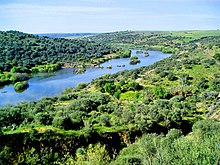Parque Natural do Vale do Guadiana
The Parque Natural do Vale do Guadiana (German Guadian Valley Nature Park ) is a nature reserve in the Portuguese province of Baixo Alentejo . It lies in the area of the small towns Mértola and Serpa in the Beja district in the south of the country . The area was designated in 1995 and covers an area of approx. 70,000 ha. The aim of the protection is to protect the landscape of the Guadian Valley and the history of the two cities in the park. The park is managed by the Instituto da Conservação da Natureza e da Biodiversidade . The park administration is based in Mértola.
To the north of the park is the Pulo do Lobo , a rapids in which the Guadiana drops in narrow cascades over 20 m. Overall, the landscape is characterized by the two main rivers and their tributaries. Here lives the Iberian midwife toad , but also several species of snakes, as the Vipera Latastei, but also some Iberian lynx ( Iberian lynx ), to storks (also the rare, resident here black stork ), Lesser Kestrel , (especially to Castro Verde ), gray Harriers ( Circus cinereus ) and the Bonelli's eagle .
However, hunting in the park was allowed at least until 2009.
Many plant species can be found here, such as Festuca duriotagana a Schwingelart , Marsilea batardae , a Kleefarngewächs , Narcissus bulbocodium or Narcissus fernandesii , Narcissus species , but also the Blazing butcher's broom or summer Twistroot .
There are around 100 archaeological sites in the park. They start from the Upper Paleolithic . The Mértola settlement dates back to around 1000 BC. BC, Serpa should also come from pre-Roman times. The Romans called Mertola Iulia Myrtilis , relics of this era were found mainly on Largo da Câmara. The remains of a Roman villa were found near Serpa. Strongly fortified by the Moors and prospering economically (the water art of Mértola comes from this time ), Mértola was expanded in the 13th century after the conquest by the Portuguese kingdom , but lost its importance in the 16th century.
From 1983 onwards, excavations brought so many finds to light that two museums were set up for them. In 2007 Serpa built one of the largest solar systems in Europe (11 MW).
Seven hiking trails between 3.5 and 14 km in length open up parts of the protected area. These are located southwest of Mértola.
The annual average temperature in the park is 16.5 ° C, with the extremes varying between 4.7 ° in January and 33.8 ° in August. The wind mostly blows from the northwest, the sunshine duration is up to over 2,800 hours per year.
See also
Web links
- Classificação | Caracterização , contribution to the park on the website of the Instituto da Conservação da Natureza e da Biodiversidade
Remarks
- ↑ Portugal starts huge solar plant , BBC, June 7, 2006.
Coordinates: 37 ° 39 ′ N , 7 ° 39 ′ W


